Russia is home to a diverse selection of beautiful bird species, both native and migratory. With a range of habitats including wetlands, forests and open steppes, Russia provides a wide variety of environments for its birds.
The country is also home to a number of endemic species, such as the Siberian Rubythroat and the Siberian Grey Shrike, that can only be found in Russia. This article will explore some of the most interesting and unique birds found in Russia, and their habitats and behaviors.
1. Pechora Pipit
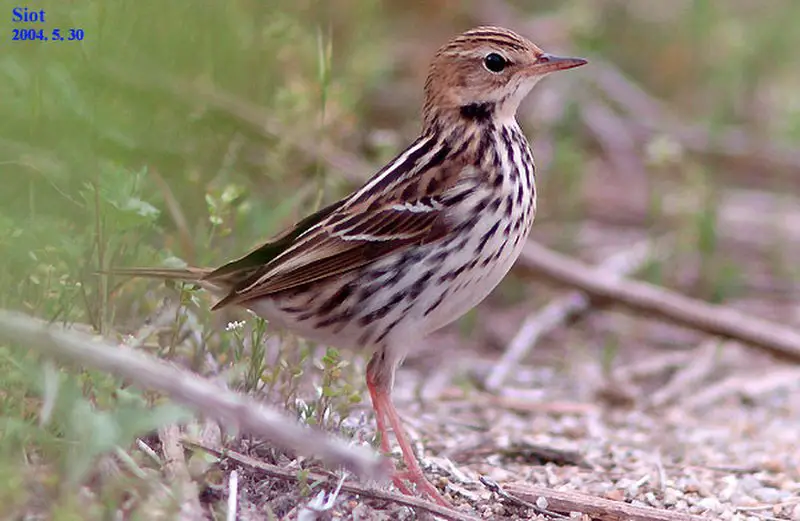
The Pechora pipit is a small passerine bird native to the East Palearctic tundra. It breeds in dense vegetation near riverbanks and coasts, ranging from the Pechora River to Chukchi Peninsula, Kamchatka and Commander Islands.
In winter it migrates long distances for survival, reaching as far away as Indonesia. The species can also be spotted rarely during September or October on western Eurasian coasts along its migration route.
Its diet mainly consists of insects with some plant material like seeds and berries added occasionally.
Due to human activities such as deforestation or wetland draining leading to habitat destruction, this species faces many threats today which necessitates effective conservation efforts by wildlife agencies across range countriesScientific classification:
| Kingdom | Animalia |
| Phylum | Chordata |
| Class | Aves |
| Order | Passeriformes |
| Family | Motacillidae |
| Genus | Anthus |
| Species | A. gustavi |
Also Featured In: Birds that Live in Faroe Islands,
2. Siberian Crane
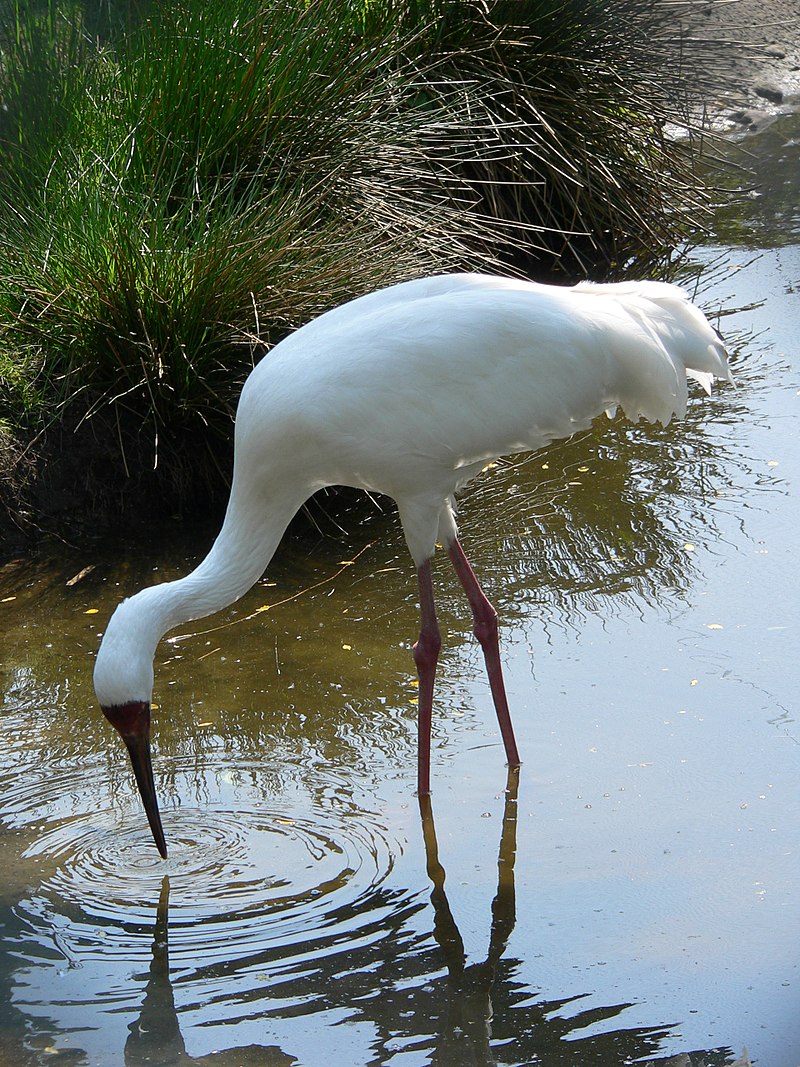
The Siberian crane is a majestic white bird of the family Gruidae. It has two distinct breeding populations in Russia, one in eastern and other in western Arctic tundra region.
In flight it can be identified by its black primary feathers which stand out against its otherwise snowy white body.
These graceful birds have an average wingspan of 2 metres and are known to migrate from their wintering grounds at India’s Keoladeo National Park to Siberia during summer months for breeding purposes.
They feed mainly on plants, grains, mollusks as well as small amphibians or fish when available near wetlands.
Due to loss of habitat and hunting these elegant cranes are listed as critically endangered species with less than 3200 individuals remaining worldwide today making them highly vulnerable to extinction if necessary conservation measures aren’t taken soon enough.Scientific classification:
| Kingdom | Animalia |
| Phylum | Chordata |
| Class | Aves |
| Order | Gruiformes |
| Family | Gruidae |
| Genus | Leucogeranus Bonaparte, 1855 |
| Species | L. leucogeranus |
3. Nordmann’s Greenshank
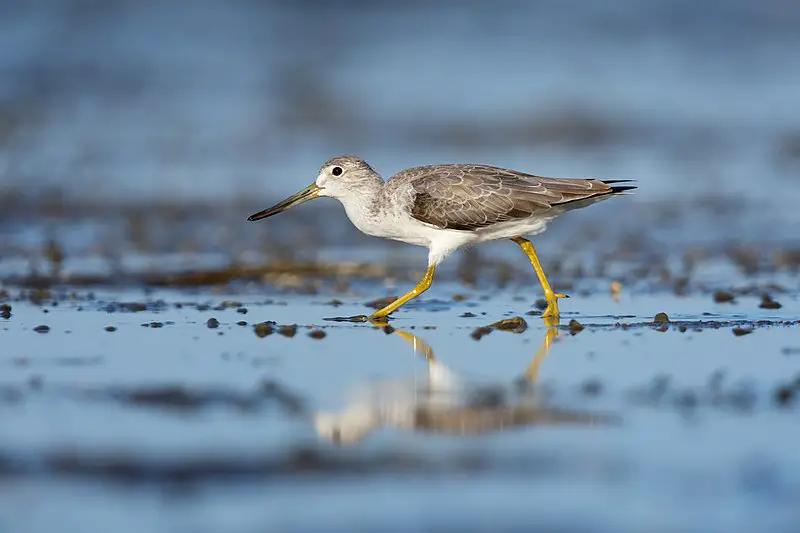
Nordmann’s greenshank is a species of wader belonging to the Scolopacidae family. It measures 29–32 cm (11-13 in) long and has an upturned bill that is bicolored; its legs are short, yellowish.
Breeding adults have white spots and streaks on their black upperside which make them easily distinguishable from other birds of similar sizes.
They inhabit coastal wetlands including estuaries, mudflats and shallow lagoons where they feed mainly on small invertebrates such as molluscs, crustaceans or aquatic insects by pecking at the surface water with their beaks.
Nordmann’s Greenshanks usually form monogamous pairs during breeding season but also large flocks outside breeding time when they migrate southwards towards tropical areas for wintering purposes.
These beautiful little creatures are considered Near threatened due to habitat destruction although some conservation actions have been taken in order to protect this species’ population levels worldwideScientific classification:
| Kingdom | Animalia |
| Phylum | Chordata |
| Class | Aves |
| Order | Charadriiformes |
| Family | Scolopacidae |
| Genus | Tringa |
| Species | T. guttifer |
Also Featured In: Most Common Birds of Sakhalin,
4. Yellow-Browed Bunting
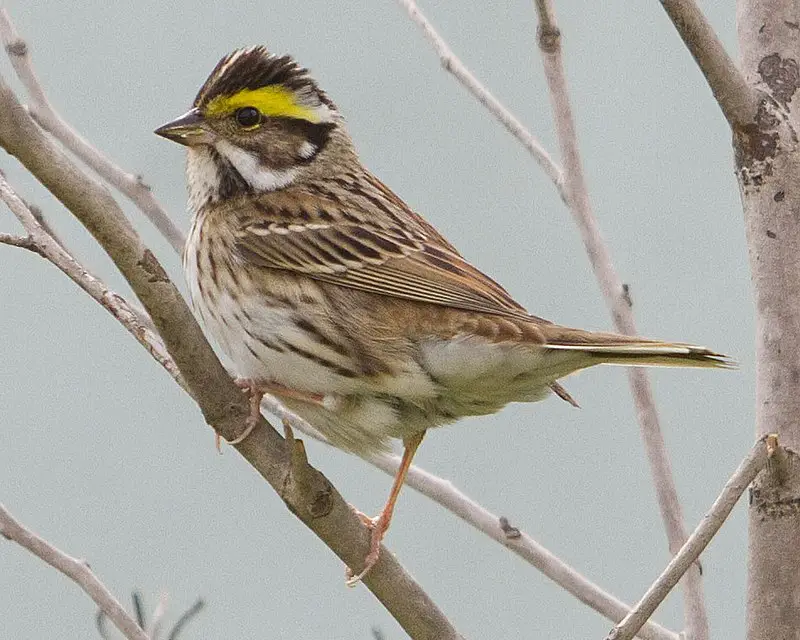
The Yellow-browed Bunting is a passerine bird, belonging to the Emberizidae family. It has been named for its distinctive yellow brow which can be found on both males and females of this species.
This bird breeds in eastern Siberia and migrates south during wintertime, travelling as far as Central Asia or even India. They prefer grasslands with shrubs and trees nearby so they have spots to perch at when looking out for prey.
The diet consists mainly of insects such as beetles, true bugs and caterpillars, but also includes some seeds too.
In addition to their unique appearance due to the bright yellow eyebrows that make them stand out from other species within their family, this bunting is quite vocal with song being composed of loud trills usually uttered from high up in trees.Scientific classification:
| Kingdom | Animalia |
| Phylum | Chordata |
| Class | Aves |
| Order | Passeriformes |
| Family | Emberizidae |
| Genus | Emberiza |
| Species | E. chrysophrys |
5. Pallas’s Rosefinch
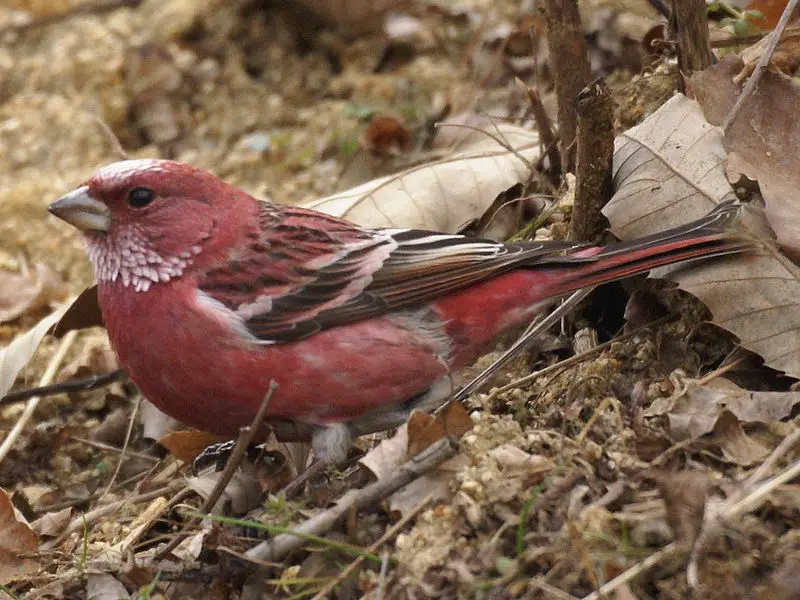
Pallas’s rosefinch is a species of bird belonging to the finch family Fringillidae. It inhabits boreal forests across China, Japan, Kazakhstan, Korea, Mongolia and Russia.
Occasional sightings have also been reported from other western regions including Britain though many may be attributed to cage-bird trade due to their exotic beauty.
They are medium sized birds with bright red colouration on breast and flanks while wings and tail feathers are greyish black in contrast.
Their diet consists mainly of seeds supplemented by insects which they find among shrubs or trees during foraging activity amidst dense vegetation cover common in their habitat range.Scientific classification:
| Kingdom | Animalia |
| Phylum | Chordata |
| Class | Aves |
| Order | Passeriformes |
| Family | Fringillidae |
| Subfamily | Carduelinae |
| Genus | Carpodacus |
| Species | C. roseus |
6. Baikal Teal
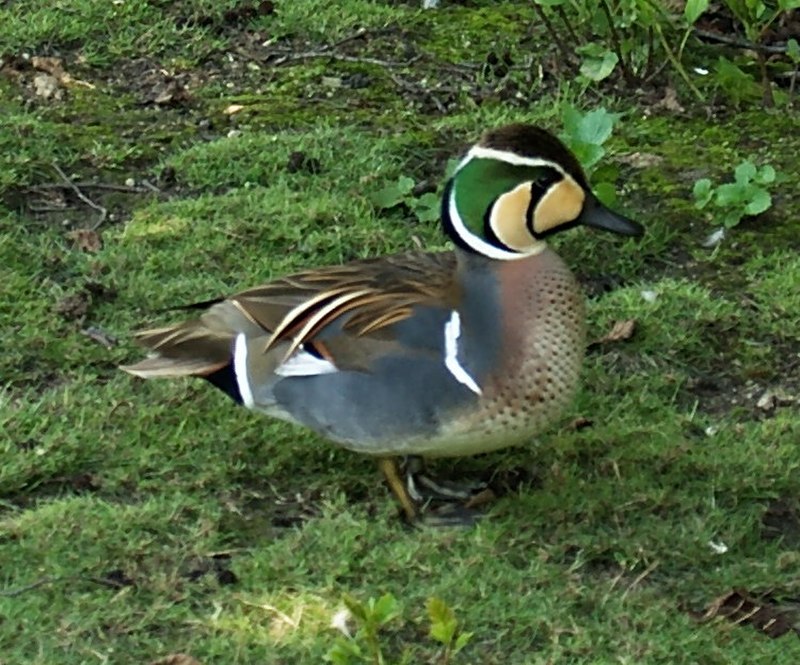
The Baikal teal is a dabbling duck native to Eastern Russia and East Asia. It was first formally described in 1775 by German naturalist Johann Gottlieb Georgi, who gave it the scientific name Anas formosa.
This species has an average body length of 46 cm (18 inches). Its plumage consists of a brownish-grey head with white patches on either side, as well as predominantly grey underparts and reddish brown wings.
The male’s call is a distinctive loud “keew”, while females make soft quacking noises when breeding or alarmed.
A molecular phylogenetic study from 2009 showed that this bird belongs to its own genus Sibirionetta instead of Anas due to distinct genetic differences between them and other members of the same family.
These ducks are highly social animals but often migrate alone during wintertime for food sources such as slugs, worms, aquatic insects and small fish found near wetlands around their habitat rangeScientific classification:
| Kingdom | Animalia |
| Phylum | Chordata |
| Class | Aves |
| Order | Anseriformes |
| Family | Anatidae |
| Genus | Sibirionetta Boetticher, 1929 |
| Species | S. formosa |
Also Featured In: Birds Commonly Found in Kyoto,
7. Spoon-Billed Sandpiper
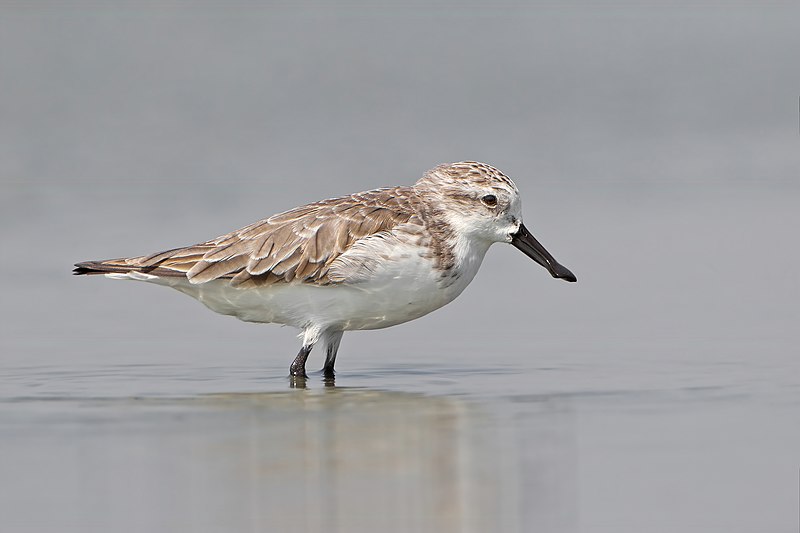
The spoon-billed sandpiper is a small wader that has been facing drastic population decline since 1970.
It breeds in the Bering Sea and winters in Southeast Asia, yet its estimated breeding population of 350 to 500 by 2000 reveals how greatly it has suffered from human activities such as overfishing and habitat destruction.
Its scientific name Platalea pygmea was proposed by Carl Linnaeus himself, highlighting just how rare this species really is.
This bird’s unique beak shape allows it to feed on crustaceans, worms, larvae and other invertebrates – however without conservation efforts these birds may soon vanish forever.Scientific classification:
| Kingdom | Animalia |
| Phylum | Chordata |
| Class | Aves |
| Order | Charadriiformes |
| Family | Scolopacidae |
| Genus | Calidris |
| Species | C. pygmaea |
8. Red-Breasted Goose
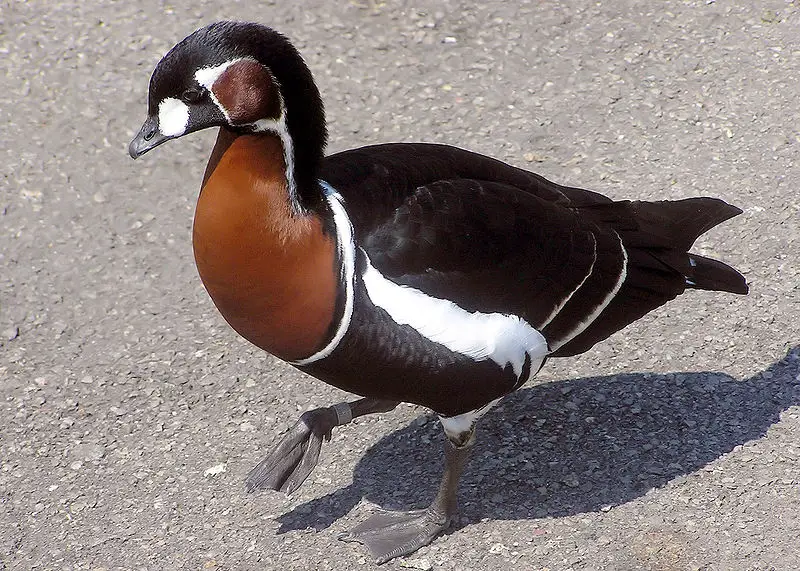
The Red-breasted Goose is a stunning bird that can often be found in Eurasia. It has bright red markings on its chest, neck and head which makes it stand out from other geese species.
The IUCN currently classifies the Red-breasted Goose as vulnerable due to population decline over recent years.
Although some authorities place this goose into its own genus Rufibrenta, most still believe it belongs within Branta bernicla due to similar structure and behaviour of both species.
To help protect this beautiful bird, conservationists are working hard to improve their habitats for breeding so that populations can continue flourishing in future generations.Scientific classification:
| Kingdom | Animalia |
| Phylum | Chordata |
| Class | Aves |
| Order | Anseriformes |
| Family | Anatidae |
| Genus | Branta |
| Species | B. ruficollis |
Also Featured In: Most Common Romanian Birds, Native Birds of Kazakhstan
9. Bean Goose
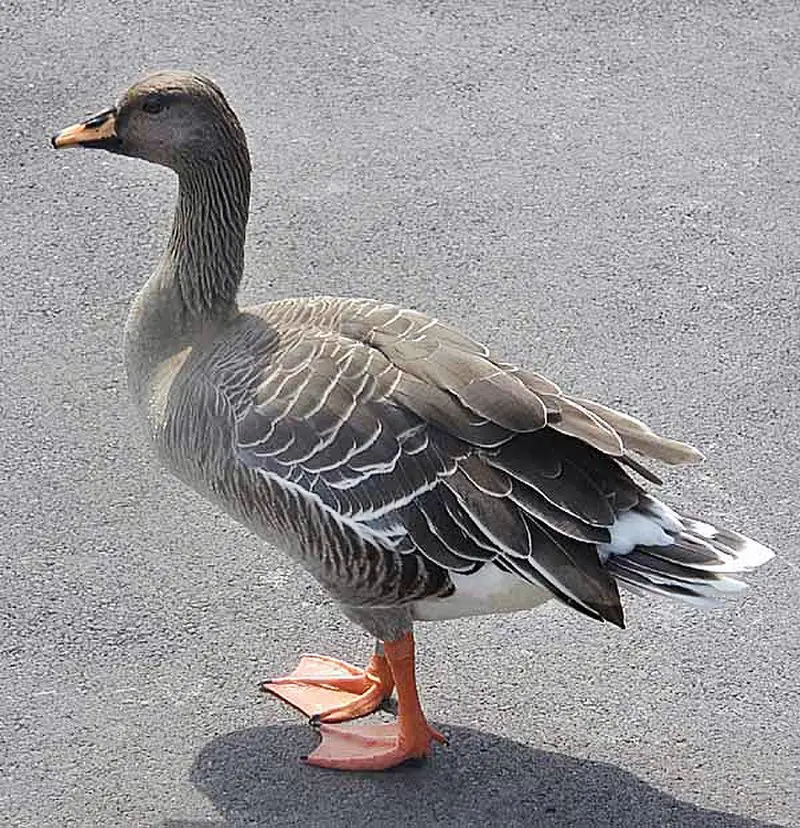
The Taiga Bean Goose is a medium sized waterfowl species that breeds in northern Europe and Asia. It has an elegant grey-brown plumage with black barring on its wings and tail, which makes it easy to identify amongst other geese.
In the winter months, this migratory bird moves further south for warmer climates.
The American Ornithological Society recognizes two subspecies of bean goose – tundra bean goose and taiga bean goose whereas some other authorities consider them as one species.
The diet of this majestic creature mainly consists of aquatic plants such as grasses, sedges or cereals depending upon season availability during migration periods.Scientific classification:
| Kingdom | Animalia |
| Phylum | Chordata |
| Class | Aves |
| Order | Anseriformes |
| Family | Anatidae |
| Genus | Anser |
| Species | A. fabalis |
Also Featured In: Common Slovakian Birds, Birds of Norfolk
10. Yellowhammer
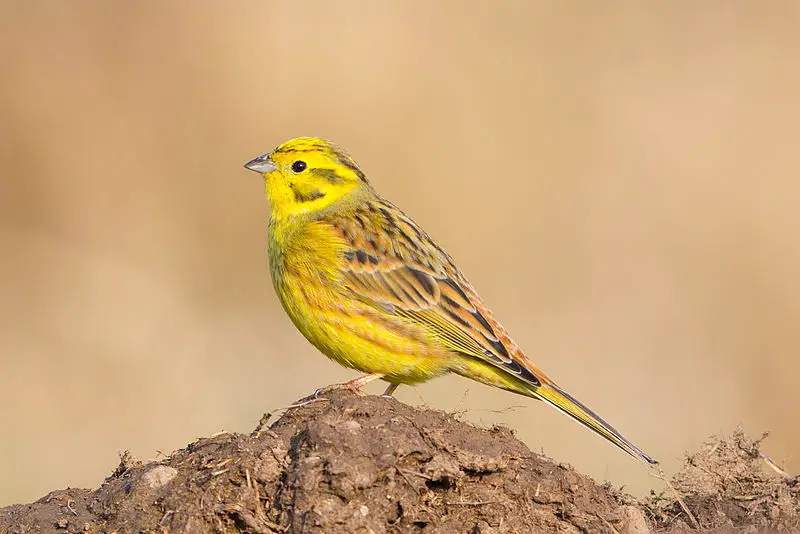
The Yellowhammer is a beautiful bird native to Eurasia and introduced in New Zealand and Australia. It belongs to the bunting family, with males having bright yellow heads, streaked brown backs, chests and bellies.
The females are more drab-colored but just as stunning. They usually remain in the breeding range year round except for eastern subspecies which migrate south during winter months.
These birds feed on insects such as beetles or grasshoppers along with fruits like cherries or pears when they can find them.
When threatened by predators they have a habit of running instead of flying away – this often helps them avoid being noticed quickly.Scientific classification:
| Kingdom | Animalia |
| Phylum | Chordata |
| Class | Aves |
| Order | Passeriformes |
| Family | Emberizidae |
| Genus | Emberiza |
| Species | E. citrinella |
Also Featured In: Birds of Sweden,
11. Rustic Bunting
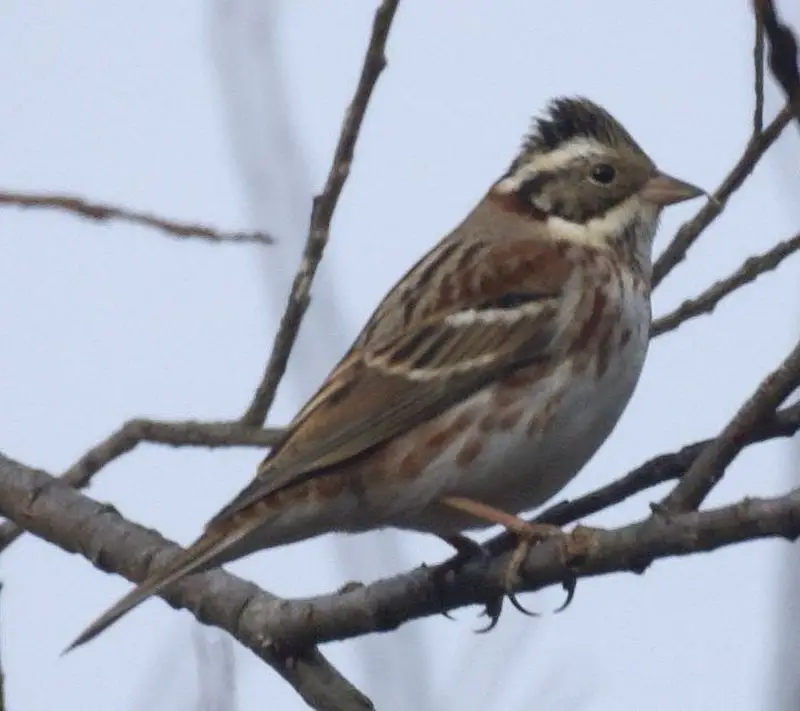
The Rustic Bunting (Emberiza rustica) is a small passerine bird belonging to the bunting family Emberizidae. This species breeds across the northern Palearctic region and migrates south during winter, reaching as far as South-East Asia, Japan, Korea and Eastern China.
It has a black cap on its head with white cheeks which contrast against its brown back feathers; males also have yellow underparts while females are more greyish or duller in color compared to their male counterparts.
These birds feed mainly on insects but can also be observed foraging for seeds and grains near farms or meadows.
They build cup-shaped nests low down among grasses where they lay 3–5 eggs at once that hatch within 14 days of incubation period by both parents taking turns looking after them until they become independent enough to leave the nest after 16–20 days.Scientific classification:
| Kingdom | Animalia |
| Phylum | Chordata |
| Class | Aves |
| Order | Passeriformes |
| Family | Emberizidae |
| Genus | Emberiza |
| Species | E. rustica |
Also Featured In: Birds You’ll Find in Hokkaido,
12. Little Bunting
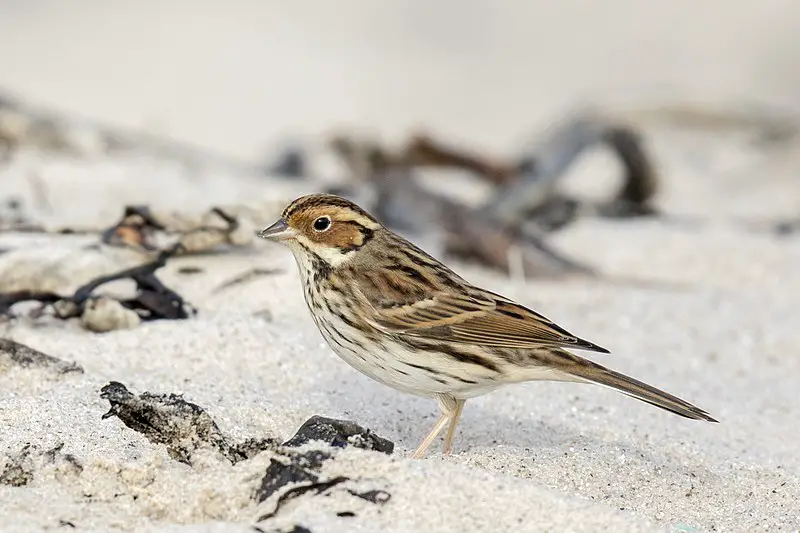
The Little Bunting (Emberiza pusilla) is a small passerine bird that belongs to the bunting family. It was first described by Peter Simon Pallas in 1776 and has no geographical variation across its wide Palearctic range.
The genus name “Emberiza” comes from Old German, meaning “bunting”. This colourful little bird usually measures between 12–14 cm long with a wingspan of 18-23cm and can be found throughout Europe, Asia and North Africa.
Its main diet consists of insects, larvae and seeds which it forages on the ground or in low vegetation during summer months.
During winter they tend to form large flocks where food sources are more plentiful. With its distinctive yellow face stripe this beautiful species adds colour to any garden.Scientific classification:
| Kingdom | Animalia |
| Phylum | Chordata |
| Class | Aves |
| Order | Passeriformes |
| Family | Emberizidae |
| Genus | Emberiza |
| Species | E. pusilla |
13. Aquatic Warbler

The Aquatic Warbler is a species of Old World warbler that can be found breeding in temperate eastern Europe and western Asia. It has an estimated population of 11,000-15,000 pairs.
This bird migrates during winter to west Africa where it spends its time until the spring months when it returns for the summer season.
Its exact whereabouts were unknown for many years but researchers eventually located them at Djoudj National Bird Sanctuary near Mauritania on the edge of the Sahara Desert.
They prefer wetland habitats such as marshes with dense reed beds which offer a suitable environment to nest and feed their young successfully each year.
With conservation efforts this species will hopefully continue to thrive in its natural habitat over coming years.Scientific classification:
| Kingdom | Animalia |
| Phylum | Chordata |
| Class | Aves |
| Order | Passeriformes |
| Family | Acrocephalidae |
| Genus | Acrocephalus |
| Species | A. paludicola |
Also Featured In: Belarus Birds You Should Know, Most Common Lithuanian Birds
14. Pallas’s Fish Eagle
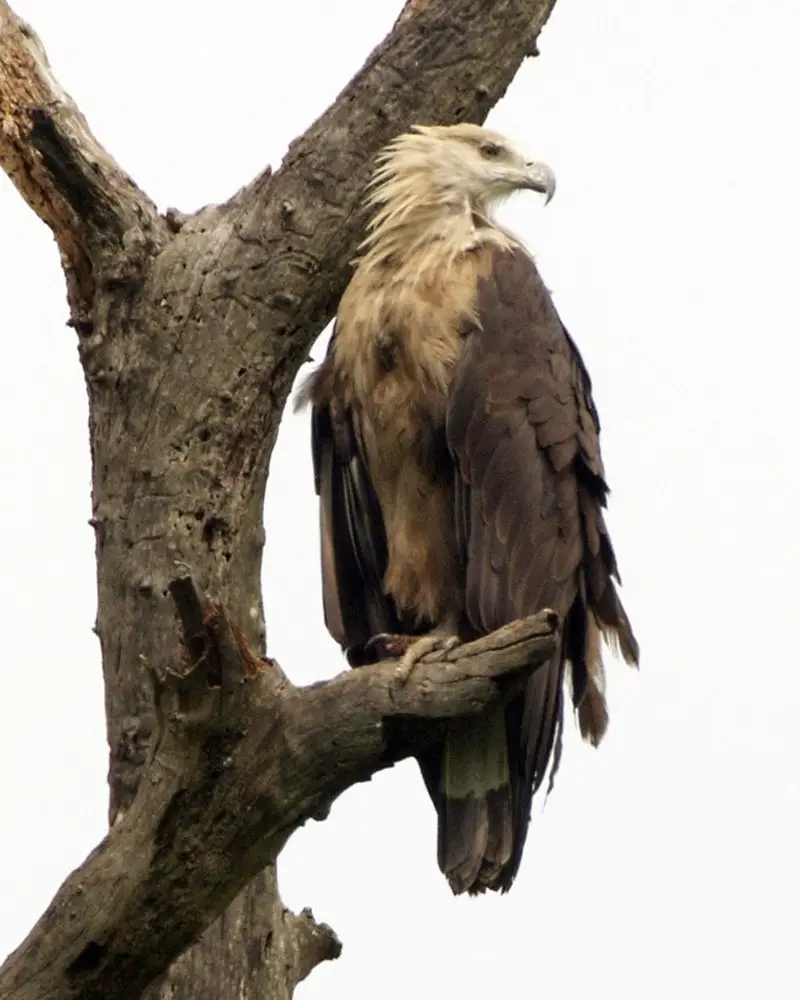
Pallas’s fish eagle is a majestic bird that breeds in east Palearctic. It has a brownish colour and is classified as Endangered on the IUCN Red List due to its decreasing population.
It migrates partially, with Central Asian birds flying south during winter months for food.
This species feeds mainly on fish which it catches near riverbanks or coasts using its sharp talons and powerful wingspan of over six feet.
Although they are difficult to spot due to their elusive nature, Pallas’s Fish Eagle remains an integral part of many ecosystems across Asia where its presence helps keep other populations healthy by controlling the number of fishes available for consumption.Scientific classification:
| Kingdom | Animalia |
| Phylum | Chordata |
| Class | Aves |
| Order | Accipitriformes |
| Family | Accipitridae |
| Genus | Haliaeetus |
| Species | H. leucoryphus |
Also Featured In: Birds that Live in Uttarakhand, Birds That You’ll See in Kaziranga National Park
15. Red-Footed Falcon
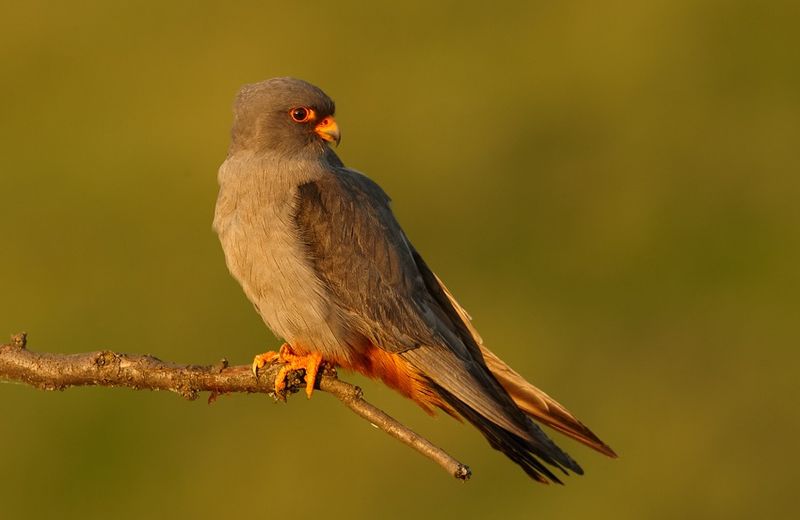
The Red-footed Falcon is a majestic bird of prey belonging to the Falconidae family. Found mainly in eastern Europe and Asia, numbers are unfortunately dwindling due to habitat loss and hunting.
This species migrates south for winter, with many birds making their way as far west as western Europe. In August 2004 one was even spotted in Britain; quite an impressive feat.
They have a striking plumage consisting of rich chestnut red legs contrasting against its grey wings and white underbelly – lending itself well to identification from afar.
The diet of this raptor mostly consists of small mammals such as mice or voles but it has also been known to feed on insects too.
A threatened species, conservation efforts must be made if we wish for generations after us to appreciate these beautiful falcons that soar across our skies.Scientific classification:
| Kingdom | Animalia |
| Phylum | Chordata |
| Class | Aves |
| Order | Falconiformes |
| Family | Falconidae |
| Genus | Falco |
| Species | F. vespertinus |
Also Featured In: Ukrainian Birds You Should Know, European Birds
16. Saker Falcon
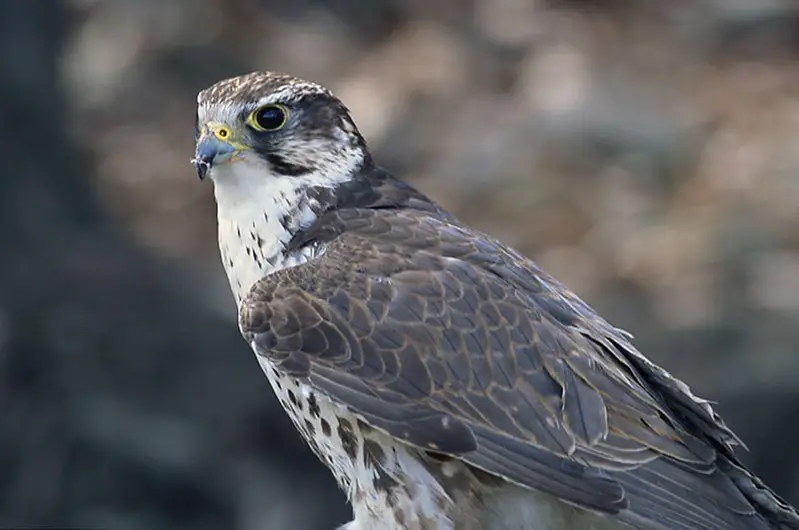
The saker falcon is a large species of falcon that is found across the Palearctic from central Europe all the way to Manchuria.
It typically migrates, except for in southern parts of its range where it winters in Ethiopia, Arabia, northern Pakistan and China.
This majestic bird has been designated as the national bird of Hungary, United Arab Emirates and Mongolia due to its beauty and gracefulness.
Its plumage can be brownish-grey or light grey with dark spots while they have bright yellow eyes which contrast their feathers beautifully.
They are also quite agile when flying at high speeds with wingspan ranging between 1-1.5 m long – perfect for soaring.Scientific classification:
| Kingdom | Animalia |
| Phylum | Chordata |
| Class | Aves |
| Order | Falconiformes |
| Family | Falconidae |
| Genus | Falco |
| Subgenus | Hierofalco |
| Species | F. cherrug |
17. Bar-Tailed Godwit
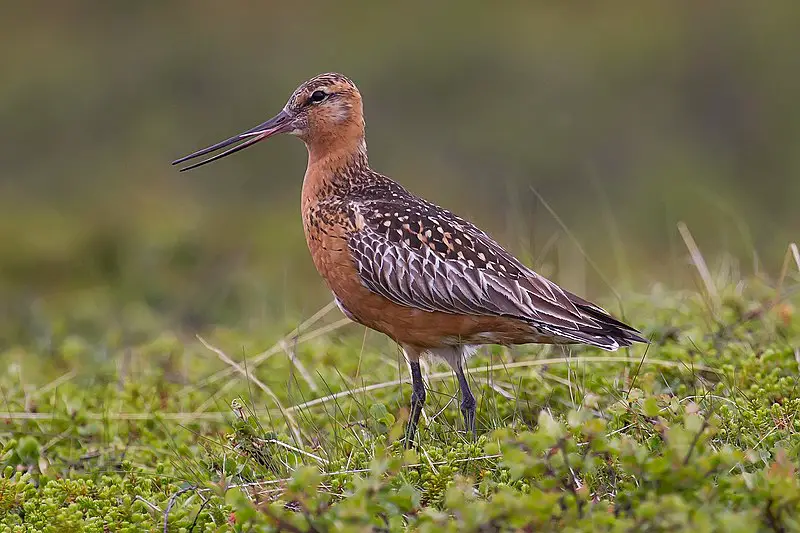
The bar-tailed godwit is a remarkable bird, both in its appearance and behavior. Its striking red breeding plumage stands out amongst the typical browns of other waders.
Long legs help it traverse coastal mudflats and estuaries where it forages on bristle-worms and shellfish.
It has an upturned bill that gives it further distinction from other shorebirds.
Bar-tailed godwits breed on Arctic coasts stretching all the way to Alaska during summer months before migrating south towards warmer temperate or tropical regions for wintering each year – quite incredible.
Despite their long migratory journeys they are still considered a common species due to large numbers making these arduous trips annually, although some populations have experienced declines recently.Scientific classification:
| Kingdom | Animalia |
| Phylum | Chordata |
| Class | Aves |
| Order | Charadriiformes |
| Family | Scolopacidae |
| Genus | Limosa |
| Species | L. lapponica |
Also Featured In: Flight Birds You Should Know, Estuaries Birds